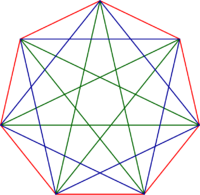Heptagonal triangle

In Euclidean geometry, a heptagonal triangle is an obtuse, scalene triangle whose vertices coincide with the first, second, and fourth vertices of a regular heptagon (from an arbitrary starting vertex). Thus its sides coincide with one side and the adjacent shorter and longer diagonals of the regular heptagon. All heptagonal triangles are similar (have the same shape), and so they are collectively known as the heptagonal triangle. Its angles have measures and and it is the only triangle with angles in the ratios 1:2:4. The heptagonal triangle has various remarkable properties.
Key points
The heptagonal triangle's nine-point center is also its first Brocard point.[1]:Propos. 12
The second Brocard point lies on the nine-point circle.[2]:p. 19
The circumcenter and the Fermat points of a heptagonal triangle form an equilateral triangle.[1]:Thm. 22
The distance between the circumcenter O and the orthocenter H is given by[2]:p. 19
where R is the circumradius. The squared distance from the incenter I to the orthocenter is[2]:p. 19
where r is the inradius.
The two tangents from the orthocenter to the circumcircle are mutually perpendicular.[2]:p. 19
Relations of distances
Sides
The heptagonal triangle's sides a < b < c coincide respectively with the regular heptagon's side, shorter diagonal, and longer diagonal. They satisfy[3]:Lemma 1
(the latter[2]:p. 13 being the optic equation) and hence
and[3]:Coro. 2
Thus –b/c, c/a, and a/b all satisfy the cubic equation
However, no algebraic expressions with purely real terms exist for the solutions of this equation, because it is an example of casus irreducibilis.
The approximate relation of the sides is
satisfy the cubic equation
We also have[4]
satisfy the cubic equation
We also have[4]
satisfy the cubic equation
We also have[2]:p. 14
and[2]:p. 15
We also have[4]
There are no other (m, n), m, n > 0, m, n < 2000 such that[citation needed]
Altitudes
The altitudes ha, hb, and hc satisfy
- [2]:p. 13
and
- [2]:p. 14
The altitude from side b (opposite angle B) is half the internal angle bisector of A:[2]:p. 19
Here angle A is the smallest angle, and B is the second smallest.
Internal angle bisectors
We have these properties of the internal angle bisectors and of angles A, B, and C respectively:[2]:p. 16
Circumradius, inradius, and exradius
The triangle's area is[6]
where R is the triangle's circumradius.
We have[2]:p. 12
We also have[7]
The ratio r /R of the inradius to the circumradius is the positive solution of the cubic equation[6]
In addition,[2]:p. 15
We also have[7]
In general for all integer n,
where
and
We also have[7]
We also have[4]
The exradius ra corresponding to side a equals the radius of the nine-point circle of the heptagonal triangle.[2]:p. 15
Orthic triangle
The heptagonal triangle's orthic triangle, with vertices at the feet of the altitudes, is similar to the heptagonal triangle, with similarity ratio 1:2. The heptagonal triangle is the only obtuse triangle that is similar to its orthic triangle (the equilateral triangle being the only acute one).[2]:pp. 12–13
Trigonometric properties
Trigonometric identities
The various trigonometric identities associated with the heptagonal triangle include these:[2]:pp. 13–14[6][7]
[4]:Proposition 10
Cubic polynomials
The cubic equation has solutions[2]:p. 14
The positive solution of the cubic equation equals [10]:p. 186–187
The roots of the cubic equation are[4]
The roots of the cubic equation are
The roots of the cubic equation are
The roots of the cubic equation are
The roots of the cubic equation are
Sequences
For an integer n, let
| Value of n: | 0 | 1 | 2 | 3 | 4 | 5 | 6 | 7 | 8 | 9 | 10 | 11 | 12 | 13 | 14 | 15 | 16 | 17 | 18 | 19 | 20 |
|---|---|---|---|---|---|---|---|---|---|---|---|---|---|---|---|---|---|---|---|---|---|
Ramanujan identities
We also have Ramanujan type identities,[7][11]
References
- ↑ 1.0 1.1 Paul Yiu, "Heptagonal Triangles and Their Companions", Forum Geometricorum 9, 2009, 125–148. http://forumgeom.fau.edu/FG2009volume9/FG200912.pdf
- ↑ 2.00 2.01 2.02 2.03 2.04 2.05 2.06 2.07 2.08 2.09 2.10 2.11 2.12 2.13 2.14 2.15 2.16 Leon Bankoff and Jack Garfunkel, "The heptagonal triangle", Mathematics Magazine 46 (1), January 1973, 7–19.
- ↑ 3.0 3.1 Abdilkadir Altintas, "Some Collinearities in the Heptagonal Triangle", Forum Geometricorum 16, 2016, 249–256.http://forumgeom.fau.edu/FG2016volume16/FG201630.pdf
- ↑ 4.0 4.1 4.2 4.3 4.4 4.5 4.6 4.7 4.8 Wang, Kai. “Heptagonal Triangle and Trigonometric Identities”, Forum Geometricorum 19, 2019, 29–38.
- ↑ Wang, Kai. https://www.researchgate.net/publication/335392159_On_cubic_equations_with_zero_sums_of_cubic_roots_of_roots
- ↑ 6.0 6.1 6.2 Weisstein, Eric W. "Heptagonal Triangle." From MathWorld--A Wolfram Web Resource. http://mathworld.wolfram.com/HeptagonalTriangle.html
- ↑ 7.0 7.1 7.2 7.3 7.4 7.5 Wang, Kai. https://www.researchgate.net/publication/327825153_Trigonometric_Properties_For_Heptagonal_Triangle
- ↑ Victor Hugo Moll, An elementary trigonometric equation, https://arxiv.org/abs/0709.3755, 2007
- ↑ 9.0 9.1 Wang, Kai. https://www.researchgate.net/publication/336813631_Topics_of_Ramanujan_type_identities_for_PI7
- ↑ Gleason, Andrew Mattei (March 1988). "Angle trisection, the heptagon, and the triskaidecagon". The American Mathematical Monthly 95 (3): 185–194. doi:10.2307/2323624. Archived from the original. Error: If you specify
|archiveurl=, you must also specify|archivedate=. https://web.archive.org/web/20151219180208/http://apollonius.math.nthu.edu.tw/d1/ne01/jyt/linkjstor/regular/7.pdf#3. - ↑ Roman Witula and Damian Slota, New Ramanujan-Type Formulas and Quasi-Fibonacci Numbers of Order 7, Journal of Integer Sequences, Vol. 10 (2007).
 |

